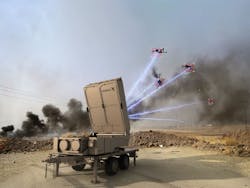Air Force surveys industry for technologies in EMP electromagnetic weapons to counter unmanned aircraft
ROME, N.Y. – U.S. Air Force researchers are surveying industry for enabling technologies in using ground- or aircraft-based electro-magnetic pulse (EMP) generation to counter formations of enemy unmanned aerial vehicles (UAVs).
Officials of the Air Force Research Laboratory Information Directorate in Rome, N.Y., issued a request for information (RFI) on Thursday for the Electromagnetic Pulse (EMP) Defense Against Unmanned Aircraft Systems (UAS) project.
EMP is an electromagnetic warfare weapon that generates high-power microwaves intended to destroy or disable sensitive electronic components -- such as the navigation, guidance, and sensor systems of UAVs.
EMP also is a byproduct of a nuclear explosion, which produces a devastatingly powerful electromagnetic field that causes massive power surges that can destroy electronics, power generation, and electric distribution systems.
Proposed electromagnetic weapons EMP solutions for this counter-UAV project could be ground or aerial based that provide effective mitigation against large-, medium-, and small-sized military UAVs.
Proposed aerial solutions must be reusable, and made from U.S. components and electronics. Aerial and ground-based solutions must have some level of system autonomy; resist the effects of shock, dirt, water, and temperature extremes; and be able to operate at night.
Companies interested should email 10-page capability statements no later than 5 Jan. 2024 to the Air Force's Matthew Zawisza at [email protected].
More information is online at https://sam.gov/opp/0df436d156e046a1a7101409f1712c48/view.
